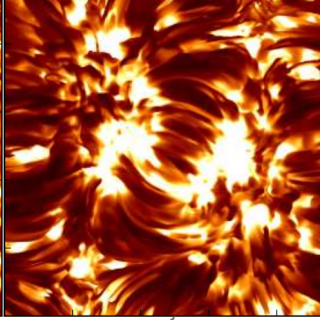Bibcode
Arregui, I.; Asensio Ramos, A.
Bibliographical reference
Astronomy and Astrophysics, Volume 565, id.A78, 4 pp.
Advertised on:
5
2014
Journal
Citations
20
Refereed citations
20
Description
Context. Time and spatial damping of transverse magnetohydrodynamic
(MHD) kink oscillations is a source of information on the cross-field
variation of the plasma density in coronal waveguides. Aims: We
show that a probabilistic approach to the problem of determining the
density structuring from the observed damping of transverse oscillations
enables us to obtain information on the two parameters that characterise
the cross-field density profile. Methods: The inference is
performed by computing the marginal posterior distributions for density
contrast and transverse inhomogeneity length-scale using Bayesian
analysis and damping ratios for transverse oscillations under the
assumption that damping is produced by resonant absorption.
Results: The obtained distributions show that, for damping times of a
few oscillatory periods, low density-contrasts and short inhomogeneity
length scales are more plausible to explain observations.
Conclusions: This means that valuable information on the cross-field
density profile can be obtained even if the inversion problem, with two
unknowns and one observable, is a mathematically ill-posed problem.
Related projects

Numerical Simulation of Astrophysical Processes
Numerical simulation through complex computer codes has been a fundamental tool in physics and technology research for decades. The rapid growth of computing capabilities, coupled with significant advances in numerical mathematics, has made this branch of research accessible to medium-sized research centers, bridging the gap between theoretical and
Daniel Elías
Nóbrega Siverio

Solar and Stellar Magnetism
Magnetic fields are at the base of star formation and stellar structure and evolution. When stars are born, magnetic fields brake the rotation during the collapse of the mollecular cloud. In the end of the life of a star, magnetic fields can play a key role in the form of the strong winds that lead to the last stages of stellar evolution. During
Tobías
Felipe García

Magnetism, Polarization and Radiative Transfer in Astrophysics
Magnetic fields pervade all astrophysical plasmas and govern most of the variability in the Universe at intermediate time scales. They are present in stars across the whole Hertzsprung-Russell diagram, in galaxies, and even perhaps in the intergalactic medium. Polarized light provides the most reliable source of information at our disposal for the
Ernest
Alsina Ballester